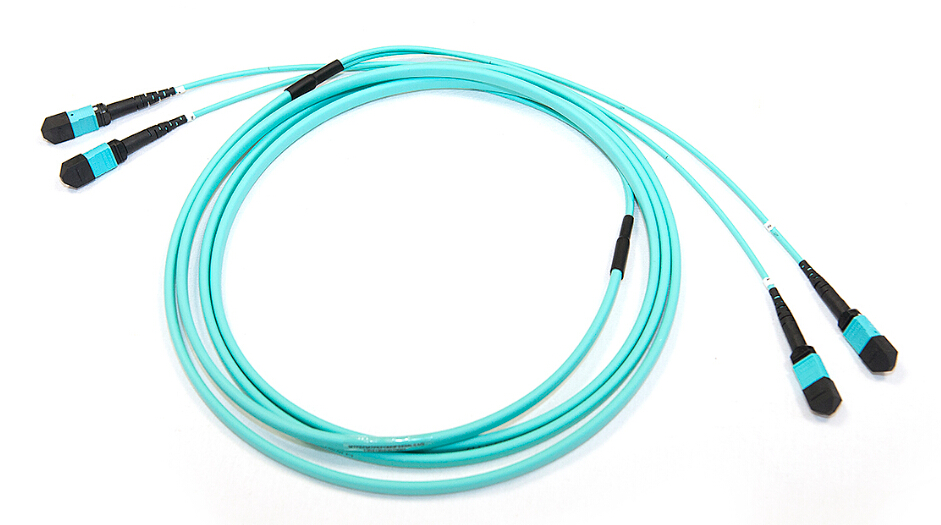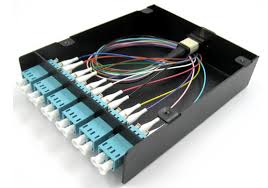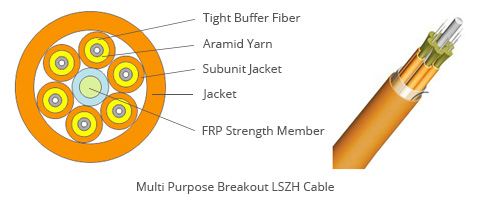To install and remove the transceiver optics in a right way is very necessary to ensure the network to work stably and efficiently. Today, we are going to introduce an installation guide of QSFP transceivers and DAC/AOC cables in 40G network.
40GbE QSFP+ Transceivers Overview
40 Gigabit Ethernet (40GbE) aggregation switches are becoming more common in today's data centers. At the heart of the 40GbE network layer is a pair of transceivers connected by a cable. The transceivers are plugged into either network servers or a variety of components including interface cards and switches and connected via the cables such as OM3 and OM4 for multimode application. Additionally DAC (Direct Attach Copper) cables or AOCs (Active Optical Cables) are used for short interconnection as a more cost-effective alternative solution. QSFP+ (Quad Small Form-factor Pluggable Plus) is the most common 40GbE interface type, and also as a high-density 10GbE interface via QSFP+ breakout cables. QSFP+ interfaces a network device (switch, router, media converter or similar device) to a fiber optic or copper cable, supporting data rates from 4x10 Gbps and supports Ethernet, Fibre Channel, InfiniBand and SONET/SDH standards with different data rate options. Compared to CFP (C form-factor pluggable) transceiver modules, QSFP transceiver modules are more compact and more suitable for port-density application. The two basic interface specifications of QSFP+ modules respectively for multimode and single-mode applications are 40GBASE-SR4 and 40GBASE-LR4.
40GBASE-SR4 QSFP+ Module
The 40GBASE-SR4 QSFP+ module, conforming to the 802.3ba D3.2 (40GBASE-SR4) standard, provides a 40Gbps optical connection using MPO/MTP® optical connectors. This optical module integrates four data lanes in each direction with 40Gbps aggregate bandwidth and each lane can operate at 10.3125 Gbps. It is used in data centers to interconnect two Ethernet switches with 8 fiber parallel multimode fiber OM3/OM4 cables (transmission distance can be up to 100 meters using OM3 fiber or up to 150 meters using OM4 fiber).
40GBASE-LR4 QSFP+ Module
The 40GBBASE-LR4 QSFP+ module, conforming to the 802.3ba (40GBASE-LR4) standard, provides a 40Gbps optical connection using LC optical connectors. This optical module integrates four data lanes in each direction with 40Gbps aggregate bandwidth and each lane can operate at 10.3125 Gbps. It is most commonly deployed between data center or IXP sites with single-mode fiber up to 10 km.
In addition, to satisfy a number of different objectives including support for MMF and SMF compatibility, there are other types of QSFP+ modules offered by different vendors.
How to Install/Remove QSFP+ Transceivers and DAC/AOC Cables
Preparations
To protect a QSFP+ module or cable from ESD (electro-static discharge) damage, before installing or removing a QSFP+ module or cable, be remembered that always wear an ESD wrist strap and make sure that it makes good skin contact and is securely grounded (If you are using ESD gloves, wear the wrist strap outside the ESD glove).
To Install or Remove a QSFP+ Transceiver Module
There are two types of clasp designed for a QSFP+ transceiver module—plastic clasp or a metallic clasp. Here uses the metallic clasp type as an example.
To Install a QSFP+ Transceiver Module
Step 1. Remove the QSFP+ module from its antistatic container and remove the dust covers from the module optical connector.
Step 2. Remove any rubber dust covers from the port where you are installing the QSFP+ module.
Step 3. Pivot the clasp of the module up. (Skip this step if the clasp is plastic.)
Step 4. Align the module with the port in the chassis, as shown in Figure 1.

Figure 1. Aligning the module with the port
Step 5. Holding the module, gently push in the module until it is firmly seated in the port.(see Figure 2.)

Figure 2. Install the QSFP+ module to port
Step 6. Immediately attach the patch cord with MPO connector or duplex LC connector to the QSFP+ transceiver module.(see Figure 3.)

Figure 3. Install the patch cord to the module
Note: Install the dust plug for the transceiver module if you are not to install an optical fiber into it.
To Remove a QSFP+ Transceiver Module
Step 1. Remove the optical fiber if any.
Step 2. Pivot the clasp of the module down to the horizontal position. (Skip this step if the clasp is plastic.)
Step 3. Holding the module, gently pull the module out of the port. (Figure 4)
Step 4. Place the QSFP+ transceiver into an antistatic bag.

Figure 4. Remove the QSFP+ module
To Install or Remove a 40G QSFP+ Cable
The installation and removal procedures are the same for QSFP+ DAC cables and QSFP+ AOC cables. Here uses a QSFP+ DAC cable as an example:
To Install a QSFP+ DAC Cable
Step 1. Align the QSFP+ transceiver module (with the clasp on top) at one end of the cable with the port in the chassis, as shown in Figure 5.
Step 2. Horizontally and gently push in the module to fully seat it in the port.

Figure 5. Installing a QSFP+ DAC cable
To remove a QSFP+ DAC Cable
Step 1. Gently press and release the QSFP+ transceiver module.(see Figure 6.)
Step 2. Holding the cable, gently pull the clasp on the cable to pull out the transceiver module.

Figure 6. Removing a QSFP+ DAC cable
To Install or Remove a 40G QSFP+ to 4x10G SFP+ Cable
40G QSFP+ to 4x10G SFP+ cable combines one 40G QSFP+ module on one end and four 10G SFP+ module on the other end. The installation and removal procedures of 40G QSFP+ connector are introdueced above. Here only introduced the installation and removal of 10G SFP+ module:
To Install an SFP+ Transceiver Module
Step 1. Align the module with the SFP+ port, with the golden plating facing the spring tab (see Figure 7.) in the SFP+ port. If the chassis has two rows of ports, the spring tab in a port is on the bottom in the upper row and on the top in the lower row.
Step 2. Slightly press the module against the spring tab so you can push the module straight into the port.

Figure 7. Installing an SFP+ transceiver module
To Remove an SFP+ Transceiver Module
Step 1. Press the module with your thumb, as shown by callout 1 in Figure 8.
Step 2. Gently pull the clasp on the cable to pull out the transceiver module, as shown by callout 2 in Figure 8.

Figure 8. Removing an SFP+ transceiver module
Verifying the installation
Execute the display transceiver interface command on the device to verify that the transceiver module or DAC/AOC cable is installed correctly. If the transceiver module and DAC/AOC cable information is displayed correctly, the installation is correct. If an error message is displayed, the installation is incorrect or the transceiver optics is not compatible.
Conclusion
As 40 GbE are widely deployed, 40G transceiver optics are ubiquitous. A good practice and correct installation are very important for 40G network system, not only to protect the 40G transceiver optics and device from damage, but also to ensure a stable performance for system. In addition, by executing the display transceiver interface command, we can verify whether the installation is correct. Of course, the premise is that the transceiver optics you use is fully compatible with your device. COMPUFOX offers a comprehensive line of high-compatible 40G transceiver optics, such as 40GBASE-SR4 QSFP+, 40GBASE-LR4 QSFP+ and 40G DACs and AOCs with competitive prices. See Links below:
Read more »



















